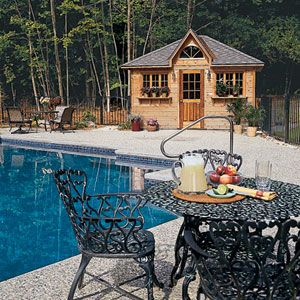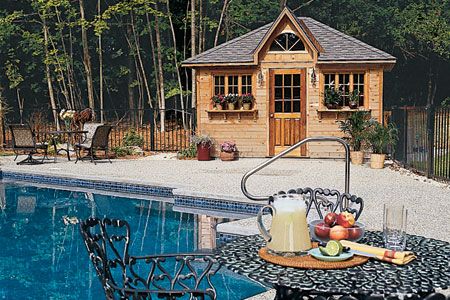
A cabana is a versatile structure that offers a perfect blend of functionality and style, providing storage, shelter, and a touch of luxury to your poolside area. Whether you’re envisioning a Hollywood-inspired oasis or simply need a practical solution for pool equipment and gear, a cabana can transform your backyard into a personal retreat. In this comprehensive guide, we’ll explore everything you need to know about building a cabana, from planning and design to construction and maintenance.
What Is a Cabana and Its Purpose?
A cabana is a small, freestanding structure typically found near swimming pools or beach areas. Its primary purpose is to provide shelter, privacy, and convenience for pool users. Cabanas often serve multiple functions, including:
- Changing area for swimmers
- Storage space for pool equipment and accessories
- Shelter from sun and rain
- Housing for pool machinery and chemicals
- Relaxation spot for lounging and entertaining
Unlike a gazebo, which is open on all sides, a cabana usually has at least one enclosed wall and often features amenities like built-in seating, mini-fridges, or even small bathrooms.
Planning Your Cabana Project
Before diving into construction, careful planning is a good idea to think about how your cabana can fit your needs and complement your outdoor space.
Determining the Ideal Size
The size of your cabana depends on its intended use and available space. Standard cabanas range from 10×10 feet to 12×14 feet, but custom sizes are possible. Think about how you’ll use the space and what items you’ll store inside. It’s often better to err on the side of a slightly larger structure to accommodate future needs.
Choosing the Right Location
Select a spot that’s convenient to access from the pool but doesn’t obstruct views or traffic flow. Consider factors such as:
- Proximity to the pool
- Sun exposure and shade
- Privacy from neighbors
- Existing landscaping
- Utility connections (if needed)
Budget Considerations
Cabana costs can vary widely based on size, materials, and features. A basic kit may start around $3,000, while custom-built options can exceed $45,000. Factor in additional expenses such as:
- Foundation or slab
- Labor costs (if not DIY)
- Electrical and plumbing work
- Interior finishes and furnishings
- Permits and inspections
All cost data from this article is sourced from Angi.
Types of Cabanas
There are several approaches to building a cabana, each with its own advantages.
Ready-to-Assemble Kits
Ready-to-assemble kits offer a convenient and often cost-effective solution. These kits come with pre-cut materials and detailed instructions, making them ideal for DIY enthusiasts. As Genine Tillotson experienced, “We absolutely wanted a place to store all the pool gear and chemicals and to hide the equipment. ” She chose a kit from Summerwood Outdoors that included everything needed for construction.
Custom-Built Cabanas
For a truly unique cabana tailored to your specific needs and design preferences, custom-built options allow for maximum flexibility. While potentially more expensive, this route ensures a perfect fit for your space and style.
Prefabricated Cabanas
Prefabricated cabanas come as fully assembled units or in large, pre-built panels. These offer quick installation and a consistent finish but may have limited customization options.
Essential Features of a Cabana
When designing your cabana, consider incorporating these key features:
Storage Solutions
Efficient storage is crucial for keeping pool areas tidy. Include shelving, hooks, and cabinets to organize:
- Towels and swimwear
- Pool toys and floats
- Cleaning supplies
- Outdoor furniture cushions
Pool Equipment Housing
A dedicated area for pool equipment keeps machinery out of sight and protected from the elements. This space should be well-ventilated and easily accessible for maintenance.
Changing Area
A private changing space adds convenience for swimmers and guests. Include benches, hooks for clothing, and possibly a full-length mirror.
Design Elements and Customization Options for a Cabana
Personalizing your cabana ensures it complements your home and landscape while meeting your specific needs.
Roof Styles
Choose a roof style that matches your home’s architecture:
- Gable roof for a classic look
- Hip roof for added weather protection
- Flat roof for a modern aesthetic
- Pergola-style for an open, airy feel
Door and Window Choices
Doors and windows affect both functionality and appearance:
- French doors for an elegant entrance
- Sliding doors to maximize space
- Louvered windows for ventilation
- Fixed windows for natural light
Siding Materials
Select siding that’s durable and weather-resistant:
- Wood for a natural look
- Vinyl for low maintenance
- Fiber cement for longevity
- Stucco for a Mediterranean feel
Interior Appointments
Enhance comfort and usability with interior features:
- Built-in seating or daybeds
- Mini-fridge or wet bar
- Ceiling fans for air circulation
- Decorative lighting fixtures
The Cabana Construction Process
Building a cabana can be approached as a DIY project or left to professionals, depending on your skills and how much you’re willing to invest.
DIY Assembly
For those comfortable with construction, a kit can be a rewarding experience. Follow these steps:
- Prepare the site and lay the foundation
- Assemble the frame according to kit instructions
- Install roofing and siding
- Add doors and windows
- Complete interior finishes and electrical work
Hiring a Professional
Professional construction ensures proper installation and can save time. When hiring a contractor:
- Get multiple quotes
- Check references and past work
- Ensure they’re licensed and insured
- Discuss a timeline and payment schedule
Cabana Maintenance and Upkeep
Regular maintenance keeps your cabana looking great.
Cleaning and Sanitizing
Establish a routine cleaning schedule:
- Sweep and mop floors regularly
- Wipe down surfaces with appropriate cleaners
- Clean windows and doors
- Wash fabric items like curtains or cushions
Weatherproofing
Protect your cabana from the elements:
- Apply water sealant to wood surfaces
- Check and replace caulking around windows and doors
- Inspect the roof for damage after storms
- Ensure proper drainage around the structure
Seasonal Care
Prepare your cabana for changing seasons:
- Store or cover outdoor furniture in winter
- Clean gutters and downspouts in autumn
- Check for pest infestations in spring
- Trim nearby vegetation in summer
Legal Considerations and Permits for Cabanas
Before building your cabana, research local regulations:
- Check zoning laws for setback requirements
- Obtain necessary building permits
- Ensure compliance with pool safety regulations
- Consider homeowners association rules, if applicable
Our Conclusion
A well-designed cabana can significantly enhance your pool area, providing both practical benefits and a touch of luxury. Whether you opt for a ready-to-assemble kit or a custom-built structure, careful planning and attention to detail will ensure your cabana meets your needs and complements your outdoor space.

